-
The Olive Ridley
Sea Turtle
-
Lepidochelys olivacea (Eschscholitz
, 1829)
Introduction
Morphology
Distribution
Vernacular
names
Food habits
Nesting
Threats to
survival
Arribadas
Introduction
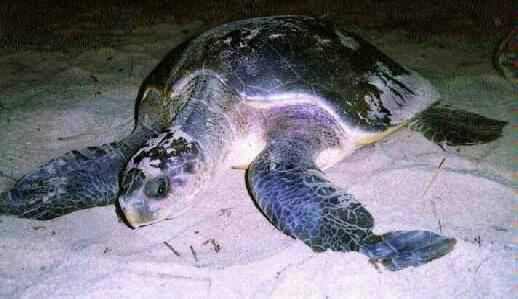 Sea
turtles have evolved from land-dwelling reptiles which laid eggs and they
have retained this one vital link with life on land. The female turtle
comes ashore during the nesting period to dig a pit and lay a nest on a
sandy beach above the high tide mark. During incubation many nests are
destroyed by predators and the hatching turtles are heavily preyed upon
as they enter the sea. Many are lost to predators as they grow , but with
each years growth they have fewer enemies, until, when they are adults,
only very large sharks can eat them. Less than one in a thousand hatchlings
survive to adulthood.
Sea
turtles have evolved from land-dwelling reptiles which laid eggs and they
have retained this one vital link with life on land. The female turtle
comes ashore during the nesting period to dig a pit and lay a nest on a
sandy beach above the high tide mark. During incubation many nests are
destroyed by predators and the hatching turtles are heavily preyed upon
as they enter the sea. Many are lost to predators as they grow , but with
each years growth they have fewer enemies, until, when they are adults,
only very large sharks can eat them. Less than one in a thousand hatchlings
survive to adulthood.
 The
Olive Ridley is the most common turtle nesting on the Indian Coast. It
is the smallest of all the sea turtles and is named for the color of its
olive shaped shell. It forages off-shore in surface waters or dives to
depths of atleast 150 meters to feed on bottom dwelling shrimp, crabs,
sea urchins and other animals. The Ridley was once thought to be a solitary
nester in the 1970's however, it was discovered that, like the kemps Ridley
some populations of olive Ridley's synchronize their nesting in mass emergences
or Arribadas. Tens of thousands of Olive Ridley's nest during Arribadas
which continues for several nights. Today most populations have collapsed
as a result of over exploitation.
Chennai on the south Indian coast is
a minor nesting ground for the Olive Ridley
The
Olive Ridley is the most common turtle nesting on the Indian Coast. It
is the smallest of all the sea turtles and is named for the color of its
olive shaped shell. It forages off-shore in surface waters or dives to
depths of atleast 150 meters to feed on bottom dwelling shrimp, crabs,
sea urchins and other animals. The Ridley was once thought to be a solitary
nester in the 1970's however, it was discovered that, like the kemps Ridley
some populations of olive Ridley's synchronize their nesting in mass emergences
or Arribadas. Tens of thousands of Olive Ridley's nest during Arribadas
which continues for several nights. Today most populations have collapsed
as a result of over exploitation.
Chennai on the south Indian coast is
a minor nesting ground for the Olive Ridley
[ TOP ]
Morphology
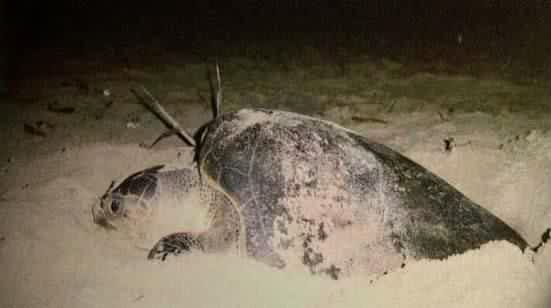 The
Olive Ridley is the smallest of all sea turtles , adults being about 60
- 70 cm in carapace length and weighing about 40 kg. In shape the adult
is very wide-shelled, the carapace having typically sloping sides and a
rather flat top. Hatchlings are uniformly charcoal gray , and immature
individuals are gray dorsally and white ventrally. Adult turtles differ
from hatchlings and sub-adults in their coloration ,having a dark olive
or greenish dorsal surface and light yellow on the plastron and ventral
aspects of the soft parts.
The
Olive Ridley is the smallest of all sea turtles , adults being about 60
- 70 cm in carapace length and weighing about 40 kg. In shape the adult
is very wide-shelled, the carapace having typically sloping sides and a
rather flat top. Hatchlings are uniformly charcoal gray , and immature
individuals are gray dorsally and white ventrally. Adult turtles differ
from hatchlings and sub-adults in their coloration ,having a dark olive
or greenish dorsal surface and light yellow on the plastron and ventral
aspects of the soft parts.
[ TOP ]
Distribution
Foraging areas
The Olive Ridley's are strongly tropical
species found within 100 km of the mainland shore. Reasonably large populations
exist in eastern Pacific from Mexico to Ecuador ; Philippines, Malaysia
, Northern Australia and Britain . In the Indian Ocean the Largest populations
occur , especially in the Bay of Bengal .
Nesting areas
The largest known nesting ground for
the Olive Ridley in the World is located in Gahirmatha, Orissa . Other
major nesting grounds include Oaxaco(Mexico) , and two sites in Pacific
Costa Rica and in lesser concentrations in Nicaragua, Panama , French Guyana
, Angola and Senegal .
[ TOP ]
Vernacular
Indian names
Bengali
: Buk-chaprano
(= chest slapping) , Faikya kossop (= winged turtle) , Faki kochchop (=
bird turtle) , Gola kochchop(= round turtle) , Jolpaironger katha (= olive
coloured turtle) , Samudrik katha( = sea turtle)
Central Nicobarese :
Kap Ngal(= turtle) , Dhivehi Vavoshi Vela(= round frame turtle)
Gujarathi
: Daryani Kachbi(= sea turtle)
Hindi :
Gadha Kachua(= donkey turtle)
Kannada
: Kardelu Aame(= sea turtle)
Lakshadweep
: Malaya Mirighan
Oriya
: Luni Kachua(= saline turtle) , Samudrik
Kachhima(= sea turtle) , Soil Kaichha
South Nicobarese
: Karasara
Tamil
: Kadal Amai (= sea turtle) , Paingili Amai(=
parrot turtle), Pul Amai (= grass turtle), Sith
Amai(= small turtle), Thenga Matteyan Amai(=
coconut husk turtle)
Telugu :
Samudram Tabelu(= sea turtle)
Other English Names
: Olive-back Loggerhead , Pacific Ridley Sea
Turtle
ANALYSIS OF SCIENTIFIC NAME
Lepidochelys (=scale turtle)
, olivacea(= olive colored).
[ TOP ]
Food habits
Olive Ridley's are reported to be carnivorous
feeding on Shrimp , snails , small crabs fish eggs, pearl oysters , echinoderms
, jelly fish , tunicates and so on . Indian ocean Olive Ridley's on the
other hand appear to be herbivorous , feeding on marine algae, which features
extensively in their diet.
[ TOP ]
Nesting
 Adult
turtles appear to migrate from long distances to shallow coastal waters
to breed and generally do so in large numbers . Mating takes place on the
surface of water , with males holding onto the carapaces of the females
with the curved claws of their fore-limbs .Copulating pairs are often seen
off nesting beaches prior to nesting .The reproductive habits of the Olive
Ridley are rather distinct. The small size and Light weight of this species
facilitates its utilization of flat wide beaches which are generally avoided
by the heavier ones. They usually come to nest only at night , but are
also seen nesting at dawn and dusk. Nesting females spend usually around
45 minutes to an hour on land.The turtle chooses a part of the beach which
is free from the action of the tide and excavates a round hole about six
feet in diameter called a Body
Pit. It is in
the body pit that they start to build their nest. A turtle may dig several
body pits before building a nest . Any noise or unfamiliar movements may
scare them .
Adult
turtles appear to migrate from long distances to shallow coastal waters
to breed and generally do so in large numbers . Mating takes place on the
surface of water , with males holding onto the carapaces of the females
with the curved claws of their fore-limbs .Copulating pairs are often seen
off nesting beaches prior to nesting .The reproductive habits of the Olive
Ridley are rather distinct. The small size and Light weight of this species
facilitates its utilization of flat wide beaches which are generally avoided
by the heavier ones. They usually come to nest only at night , but are
also seen nesting at dawn and dusk. Nesting females spend usually around
45 minutes to an hour on land.The turtle chooses a part of the beach which
is free from the action of the tide and excavates a round hole about six
feet in diameter called a Body
Pit. It is in
the body pit that they start to build their nest. A turtle may dig several
body pits before building a nest . Any noise or unfamiliar movements may
scare them . 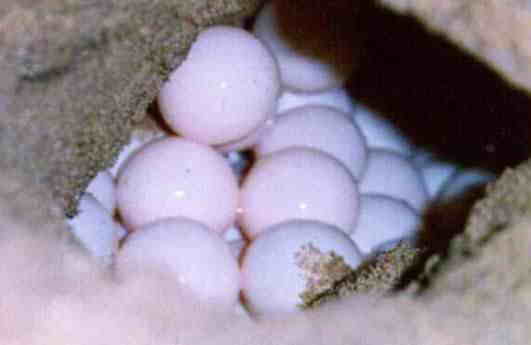 The
nests are shallow and the eggs laid have an average diameter of 3 to 5
cm. After laying the eggs and filling up the nesting cavity , the Olive
Ridley usually thumps the sand over the nesting site by means of vigorous
, side to side rocking action of the shell. Nesting may occur two to three
times in a season and unlike other species of turtles , nesting in successive
seasons occurs quite frequently.On the Chennai coast , a clutch comprises
of 80 to 160 eggs and incubation periods range between 50 and 63 days.
Hatchlings measure between 3.5 centimeters to 6 centimeters.
The
nests are shallow and the eggs laid have an average diameter of 3 to 5
cm. After laying the eggs and filling up the nesting cavity , the Olive
Ridley usually thumps the sand over the nesting site by means of vigorous
, side to side rocking action of the shell. Nesting may occur two to three
times in a season and unlike other species of turtles , nesting in successive
seasons occurs quite frequently.On the Chennai coast , a clutch comprises
of 80 to 160 eggs and incubation periods range between 50 and 63 days.
Hatchlings measure between 3.5 centimeters to 6 centimeters.
[ TOP ]
Threats
to survival
The survival of the Olive Ridley and
its offspring's is diminished by a variety of natural environmental conditions
. But the greatest threat comes from the ones that are induced by man -
made activities. The most important threats that sea turtles face are listed
below.
Disruption caused by lighting
 The
greatest and most obvious threat facing the Ridley's on the Chennai coast
is the presence of unnatural beach lighting either onshore or off-shore.
Artificial lights affect both Nesting females as well as hatchlings . There
is evidence to show that females may be discouraged from nesting on heavily
lit beaches. Hatchlings become disoriented and suffer high rates of mortality
because of bright lights .
Since Hatchlings are positively photo
tropic they are attracted by bright lights located behind the nesting beach
,and head inland rather than towards the sea .Apparently , bright lights
appear to be so irresistible that they would even run into the flames of
a beach fire.Although hatchlings will eventually be able to reorient themselves
towards the sea once the sun rises , they may be too exhausted or desiccated
to do so.
Loss of Habitat
The recent spurt in illegal mining
for beach sand poses a serious threat to the nesting habitat of the Ridley
on the Chennai coast . It can result in lowering of the beach platform
to a point that it floods at high tide or during heavy seas, making it
an unsuitable medium for incubation.
Chemical Pollution
The
greatest and most obvious threat facing the Ridley's on the Chennai coast
is the presence of unnatural beach lighting either onshore or off-shore.
Artificial lights affect both Nesting females as well as hatchlings . There
is evidence to show that females may be discouraged from nesting on heavily
lit beaches. Hatchlings become disoriented and suffer high rates of mortality
because of bright lights .
Since Hatchlings are positively photo
tropic they are attracted by bright lights located behind the nesting beach
,and head inland rather than towards the sea .Apparently , bright lights
appear to be so irresistible that they would even run into the flames of
a beach fire.Although hatchlings will eventually be able to reorient themselves
towards the sea once the sun rises , they may be too exhausted or desiccated
to do so.
Loss of Habitat
The recent spurt in illegal mining
for beach sand poses a serious threat to the nesting habitat of the Ridley
on the Chennai coast . It can result in lowering of the beach platform
to a point that it floods at high tide or during heavy seas, making it
an unsuitable medium for incubation.
Chemical Pollution
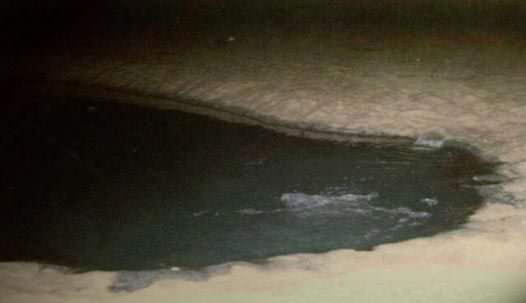 The
most obvious form of chemical pollution in the nesting habitat is Oil .
Fresh crude oil is known to cause significant mortality and morphological
changes in the incubating embryos , but weathered oil may not.
Untreated Industrial effluence
appears to deter nesting turtles in some parts
of the Chennai coast . But more research is needed to document the the
lethal effects of such chemical pollutants. Eggs , embryos and hatchlings
are more vulnerable than adults since volatile and water soluble contaminants
can be absorbed into the egg . Both oil spills and resulting clean up operations
could have harmful effects at the nesting beach.
Physical Debris
The
most obvious form of chemical pollution in the nesting habitat is Oil .
Fresh crude oil is known to cause significant mortality and morphological
changes in the incubating embryos , but weathered oil may not.
Untreated Industrial effluence
appears to deter nesting turtles in some parts
of the Chennai coast . But more research is needed to document the the
lethal effects of such chemical pollutants. Eggs , embryos and hatchlings
are more vulnerable than adults since volatile and water soluble contaminants
can be absorbed into the egg . Both oil spills and resulting clean up operations
could have harmful effects at the nesting beach.
Physical Debris
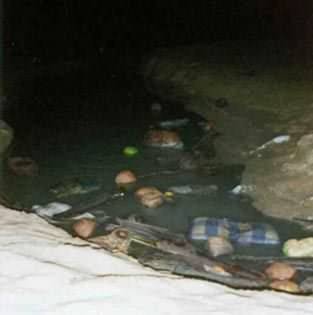 Beaches
around the world are rapidly becoming polluted by man-made debris . This
debris includes light bulbs , styrofoam , plastics , tar , wood , glass
cloth , fishing gear and organic wastes .Small objects like these , if
abundant enough , could become incorporated into the beach sand , and ultimately
alter their thermal properties or patterns of gas diffusion within it.
Coastal construction may deter or prevent
nesting females from coming ashore.
Incidental Catch
Beaches
around the world are rapidly becoming polluted by man-made debris . This
debris includes light bulbs , styrofoam , plastics , tar , wood , glass
cloth , fishing gear and organic wastes .Small objects like these , if
abundant enough , could become incorporated into the beach sand , and ultimately
alter their thermal properties or patterns of gas diffusion within it.
Coastal construction may deter or prevent
nesting females from coming ashore.
Incidental Catch
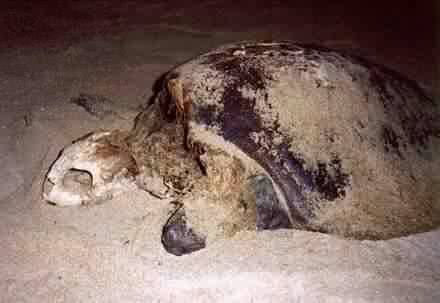 Incidental catch results in significant
mortality of Adults along the Chennai coast. The absence of Turtle Excluder
Devices (TED) can be cited as one of the major causes for this mortality
.
Incidental catch results in significant
mortality of Adults along the Chennai coast. The absence of Turtle Excluder
Devices (TED) can be cited as one of the major causes for this mortality
.
Arribadas
The Olive Ridley's are known for their
peculiar nesting strategies. Refereed to as Arribada
(meaning mass arrival in Spanish), it involves nesting in numbers that
may reach many thousands during a single night on a short stretch of beach.
One of the largest nesting grounds for the Olive Ridley in the world was
discovered in Gahirmatha, Orissa , in Eastern India.
Note : The clarity of all images has been lowered to reduce loading time . If you would like a copy of the original images , please send E-mail
 Sea
turtles have evolved from land-dwelling reptiles which laid eggs and they
have retained this one vital link with life on land. The female turtle
comes ashore during the nesting period to dig a pit and lay a nest on a
sandy beach above the high tide mark. During incubation many nests are
destroyed by predators and the hatching turtles are heavily preyed upon
as they enter the sea. Many are lost to predators as they grow , but with
each years growth they have fewer enemies, until, when they are adults,
only very large sharks can eat them. Less than one in a thousand hatchlings
survive to adulthood.
Sea
turtles have evolved from land-dwelling reptiles which laid eggs and they
have retained this one vital link with life on land. The female turtle
comes ashore during the nesting period to dig a pit and lay a nest on a
sandy beach above the high tide mark. During incubation many nests are
destroyed by predators and the hatching turtles are heavily preyed upon
as they enter the sea. Many are lost to predators as they grow , but with
each years growth they have fewer enemies, until, when they are adults,
only very large sharks can eat them. Less than one in a thousand hatchlings
survive to adulthood. The
Olive Ridley is the most common turtle nesting on the Indian Coast. It
is the smallest of all the sea turtles and is named for the color of its
olive shaped shell. It forages off-shore in surface waters or dives to
depths of atleast 150 meters to feed on bottom dwelling shrimp, crabs,
sea urchins and other animals. The Ridley was once thought to be a solitary
nester in the 1970's however, it was discovered that, like the kemps Ridley
some populations of olive Ridley's synchronize their nesting in mass emergences
or Arribadas. Tens of thousands of Olive Ridley's nest during Arribadas
which continues for several nights. Today most populations have collapsed
as a result of over exploitation.
The
Olive Ridley is the most common turtle nesting on the Indian Coast. It
is the smallest of all the sea turtles and is named for the color of its
olive shaped shell. It forages off-shore in surface waters or dives to
depths of atleast 150 meters to feed on bottom dwelling shrimp, crabs,
sea urchins and other animals. The Ridley was once thought to be a solitary
nester in the 1970's however, it was discovered that, like the kemps Ridley
some populations of olive Ridley's synchronize their nesting in mass emergences
or Arribadas. Tens of thousands of Olive Ridley's nest during Arribadas
which continues for several nights. Today most populations have collapsed
as a result of over exploitation. The
Olive Ridley is the smallest of all sea turtles , adults being about 60
- 70 cm in carapace length and weighing about 40 kg. In shape the adult
is very wide-shelled, the carapace having typically sloping sides and a
rather flat top. Hatchlings are uniformly charcoal gray , and immature
individuals are gray dorsally and white ventrally. Adult turtles differ
from hatchlings and sub-adults in their coloration ,having a dark olive
or greenish dorsal surface and light yellow on the plastron and ventral
aspects of the soft parts.
The
Olive Ridley is the smallest of all sea turtles , adults being about 60
- 70 cm in carapace length and weighing about 40 kg. In shape the adult
is very wide-shelled, the carapace having typically sloping sides and a
rather flat top. Hatchlings are uniformly charcoal gray , and immature
individuals are gray dorsally and white ventrally. Adult turtles differ
from hatchlings and sub-adults in their coloration ,having a dark olive
or greenish dorsal surface and light yellow on the plastron and ventral
aspects of the soft parts. Adult
turtles appear to migrate from long distances to shallow coastal waters
to breed and generally do so in large numbers . Mating takes place on the
surface of water , with males holding onto the carapaces of the females
with the curved claws of their fore-limbs .Copulating pairs are often seen
off nesting beaches prior to nesting .The reproductive habits of the Olive
Ridley are rather distinct. The small size and Light weight of this species
facilitates its utilization of flat wide beaches which are generally avoided
by the heavier ones. They usually come to nest only at night , but are
also seen nesting at dawn and dusk. Nesting females spend usually around
45 minutes to an hour on land.The turtle chooses a part of the beach which
is free from the action of the tide and excavates a round hole about six
feet in diameter called a Body
Pit. It is in
the body pit that they start to build their nest. A turtle may dig several
body pits before building a nest . Any noise or unfamiliar movements may
scare them .
Adult
turtles appear to migrate from long distances to shallow coastal waters
to breed and generally do so in large numbers . Mating takes place on the
surface of water , with males holding onto the carapaces of the females
with the curved claws of their fore-limbs .Copulating pairs are often seen
off nesting beaches prior to nesting .The reproductive habits of the Olive
Ridley are rather distinct. The small size and Light weight of this species
facilitates its utilization of flat wide beaches which are generally avoided
by the heavier ones. They usually come to nest only at night , but are
also seen nesting at dawn and dusk. Nesting females spend usually around
45 minutes to an hour on land.The turtle chooses a part of the beach which
is free from the action of the tide and excavates a round hole about six
feet in diameter called a Body
Pit. It is in
the body pit that they start to build their nest. A turtle may dig several
body pits before building a nest . Any noise or unfamiliar movements may
scare them .  The
nests are shallow and the eggs laid have an average diameter of 3 to 5
cm. After laying the eggs and filling up the nesting cavity , the Olive
Ridley usually thumps the sand over the nesting site by means of vigorous
, side to side rocking action of the shell. Nesting may occur two to three
times in a season and unlike other species of turtles , nesting in successive
seasons occurs quite frequently.On the Chennai coast , a clutch comprises
of 80 to 160 eggs and incubation periods range between 50 and 63 days.
Hatchlings measure between 3.5 centimeters to 6 centimeters.
The
nests are shallow and the eggs laid have an average diameter of 3 to 5
cm. After laying the eggs and filling up the nesting cavity , the Olive
Ridley usually thumps the sand over the nesting site by means of vigorous
, side to side rocking action of the shell. Nesting may occur two to three
times in a season and unlike other species of turtles , nesting in successive
seasons occurs quite frequently.On the Chennai coast , a clutch comprises
of 80 to 160 eggs and incubation periods range between 50 and 63 days.
Hatchlings measure between 3.5 centimeters to 6 centimeters. The
greatest and most obvious threat facing the Ridley's on the Chennai coast
is the presence of unnatural beach lighting either onshore or off-shore.
Artificial lights affect both Nesting females as well as hatchlings . There
is evidence to show that females may be discouraged from nesting on heavily
lit beaches. Hatchlings become disoriented and suffer high rates of mortality
because of bright lights .
The
greatest and most obvious threat facing the Ridley's on the Chennai coast
is the presence of unnatural beach lighting either onshore or off-shore.
Artificial lights affect both Nesting females as well as hatchlings . There
is evidence to show that females may be discouraged from nesting on heavily
lit beaches. Hatchlings become disoriented and suffer high rates of mortality
because of bright lights . The
most obvious form of chemical pollution in the nesting habitat is Oil .
Fresh crude oil is known to cause significant mortality and morphological
changes in the incubating embryos , but weathered oil may not.
Untreated Industrial effluence
appears to deter nesting turtles in some parts
of the Chennai coast . But more research is needed to document the the
lethal effects of such chemical pollutants. Eggs , embryos and hatchlings
are more vulnerable than adults since volatile and water soluble contaminants
can be absorbed into the egg . Both oil spills and resulting clean up operations
could have harmful effects at the nesting beach.
The
most obvious form of chemical pollution in the nesting habitat is Oil .
Fresh crude oil is known to cause significant mortality and morphological
changes in the incubating embryos , but weathered oil may not.
Untreated Industrial effluence
appears to deter nesting turtles in some parts
of the Chennai coast . But more research is needed to document the the
lethal effects of such chemical pollutants. Eggs , embryos and hatchlings
are more vulnerable than adults since volatile and water soluble contaminants
can be absorbed into the egg . Both oil spills and resulting clean up operations
could have harmful effects at the nesting beach. Beaches
around the world are rapidly becoming polluted by man-made debris . This
debris includes light bulbs , styrofoam , plastics , tar , wood , glass
cloth , fishing gear and organic wastes .Small objects like these , if
abundant enough , could become incorporated into the beach sand , and ultimately
alter their thermal properties or patterns of gas diffusion within it.
Beaches
around the world are rapidly becoming polluted by man-made debris . This
debris includes light bulbs , styrofoam , plastics , tar , wood , glass
cloth , fishing gear and organic wastes .Small objects like these , if
abundant enough , could become incorporated into the beach sand , and ultimately
alter their thermal properties or patterns of gas diffusion within it.